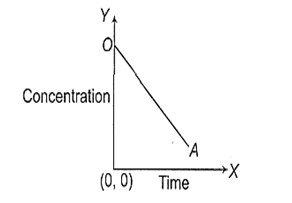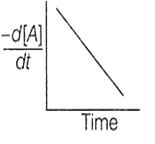 Multiple Choice Questions
Multiple Choice QuestionsA first-order reaction is 50% completed in 1.26 x 1014s. How much time would it take for 100% completion?
1.26 x 1015 s
2.52 x 1014 s
2.52 x 1028 s
Infinite
For the chemical reaction, 2O3 ⇌ 3O2. The reaction proceeds as follows
O3 ⇌ O2 + O (fast)
O + O3 → 2O2 (slow)
The rate law expression will be
r = k'[O3]2
r = k'[O3]2[O2]-1
r = k'[O3][O2]
Unpredictable
Two similar reactions have the same rate constant at 25C, but at 35C, one of the reaction has a higher rate constant than the other. The appropriate reason for this is
due to effective collisions
due to different activation energies
due to different threshold energies
due to higher population of molecules
A hypothetical reaction A 2B proceeds through the following sequence of steps
I. A C;
II. C D;
III. B;
The heat of hypothetical reaction is
q1 + q2 - 2q3
q1 + q2 + 2q3
q1 + 2q2 - 2q3
q1 - q2 + 2q3
Look at the graph,

Choose the correct equation from the following which best suited to the above graph
[At] = [A]0 -Kt
[At] = [A]0 + Kt
[At] = [A0]e-Kt
[At] = Kt2 + [A0]
Observe the following reaction
2A + B C
The rate of formation of C is 2. 2 x 10-3 mol L-3 min-1. What is the value of (in mol L-1 min-1)?
Which of the following is an example for heterogeneous catalysis reaction?
2SO2(g) + O2 2SO3(g)
Hydrolysis of aqueous sucrose solution in the presence of a aqueous mineral acid
2H2O2 (l) 2H2O2(l) + O2(g)
Hydrolysis of liquid in the presence of aqueous mineral acid
A hypothetical reaction
X2 + Y2 2XY follows the following mechanism
X2 X + X .... fast
X + Y2 XY + Y .... slow
X + Y XY .... fast
The order of overall reaction is
2
1
0
The variation of concentration of the product P with time in the reaction, A P is shown in following graph.

The graph between and time will be of the type




The average kinetic energy of an ideal gas per molecule in SI units at 25°C will be
6.17 x 10-21 JK-1
6.17 x 10-21 JK-1
6.17 x 1020 JK-1
7.16 x 10-20 JK-1
